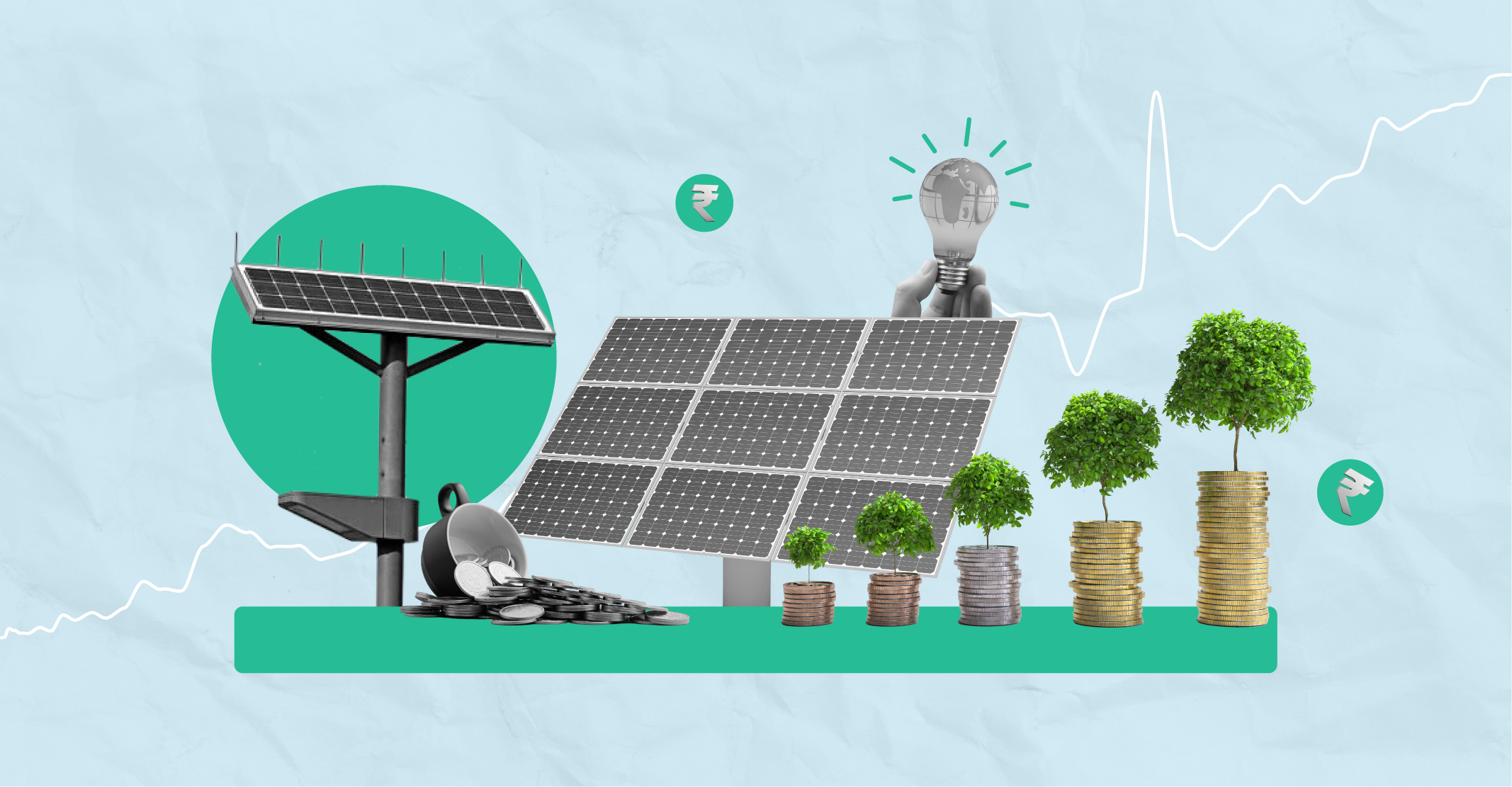Abstract
India is blessed with its strategic geopolitical location. Clear sunny weather is observed in India from 200 to 300 days per year. Its yearly radiation, which ranges from 1600 to 2200 kWh/m2, is equivalent to that experienced in tropical and subtropical areas. India being a tropical country with abundance of solar energy if strategically used with right technology and investment can fulfill the most populated country’s energy requirement and its ambitious goal of achieving net zero GHG (GreenHouse Gases) emission by 2070. With dwindling global reliance on conventional sources of energy, the world is exploring the cheap, stable, renewable and easily distributive alternative in the form of solar energy. India does not lack technology or potential investment to exploit this new transitional energy resource. What India requires is a strategic policy framework which aims to decentralize solar energy production penetrating into the grassroots level. The Government has undertaken efforts to formulate the existing legislative framework in accordance with the solar energy transition, through the Electricity Act 2003, Renewable Energy Certificates (RECs) 2011, Clean Energy Cess 2010 and Corporate Social Responsibility (CSR). However, there was a need for a policy framework in the form of subsidies, tariffs and mandates to robust India’s demand and supply of solar energy both domestically and internationally. From legislation developments to net metering incentives, India has harnessed it all by achieving the 4th rank in solar generation globally. The paper outlines the various policy incentives undertaken by the Government to create a market for solar energy production as well as consumption domestically. The said paper also analyzes India’s policy framework to strengthen its geopolitical position in the World Trade Organisation and how India incentivises its consumers to become producers in order to be self-reliant in solar production.
International Obligations and Commitments
In pursuance to the Article 4, paragraph of the Paris Agreement, India submitted its Intended Nationally Determined Contribution (INDC) to the United Nation Framework Convention on Climate Change (UNFCCC), to achieve about 50 percent cumulative electric power installed capacity from non-fossil fuel-based energy resources by 2030, with the help of transfer of technology and low-cost international finance including from Green Climate Fund (GCF).
At the UN Climate Change Conference in Glasgow (COP26) in November 2021, Prime Minister Narendra Modi outlined India’s climate action plan. He proposed a ‘Panchamrit’ of five goals:
- Reach 500GW Non-fossil energy capacity by 2030.
- 50 per cent of its energy requirements from renewable energy by 2030.
- Reduction of total projected carbon emissions by one billion tonnes from now to 2030.
- Reduction of the carbon intensity of the economy by 45 per cent by 2030, over 2005 levels.
- Achieving the target of net zero emissions by 2070.
International Solar Alliance
The International Solar Alliance (ISA) is a treaty-based inter-governmental organisation of 121 Countries having its headquarters in India. The World Bank Group in collaboration with ISA aspires to mobilize $1 trillion in investments by 2030 and to provide more than $1 billion to support India’s ambitious initiative to expand solar through investments in solar generation.
ISA now observes a Permanent Observer Status at the UN General Assembly. It has signed a Memorandum of Understanding with the United Nations Framework Convention on Climate Change (UNFCCC) at COP 26. For its strategic plan from 2021-2026, ISA aim to attain 3E’s i.e., Energy Access, Energy Security, and Energy Transition.
Requirement of Solar Energy Policies in India
The futuristic technology that we are seeing today can be traced in its rudimentary form since ancient civilisation. From keeping the homes of Neolithic Chinese villagers warm to being used as a weapon of mass destruction by the Greeks, the world has experienced it all. However, it is pertinent to note as to what prompted India to move towards the adaptation of solar energy. With the expansion of international trade in 1972, the value of exports from developing countries including India, increased of about 16% but the world was facing energy crisis due to high rate of increase in demand. Though at that time the world was much more dependent on oil prices that led to global energy crisis than the current scenario which is more dependent on fossil fuels and gas. In 1974, India topped the United Nations list of 30 developing countries affected by the global crisis.
However, even without the hike in oil prices by OPEC, India was facing the energy crisis due to the following factors:
- Firewood crisis,
- Scarcity of Capital, and
- Electricity shortages
This was the beginning of India’s efforts towards energy development through its effective policy development on living off the sun. Now with the sudden increase in the prices of oil, uncertainty pertaining to oil supply and balance of payments led to the establishment of Commission for Additional Sources of Energy in 1981. The said Commission was entrusted with the task of formulating the policies for the development of renewable energy. It was for the first time that in the 6th Five Year Plan (1980-1985), the development of solar energy and its implementation in rural areas and industrial units was addressed. Furthermore, in the year 1982, Department of Non-conventional Energy Sources was established which subsequently christened as Ministry of Non-conventional Energy Sources and Ministry of New and Renewable Energy in 1992 and 2006 respectively.
Apart from the price hike and economic instability, a large part of India’s expenditure was spent for the development of India’s Solar photovoltaic (SPV) power plants through imports from China due to its inability to manufacture critical raw materials and components. This led to rise in high prices of solar equipment.
India’s Energy Policy Framework
India’s solar energy policy framework is mainly based on three factors:
- Energy Access,
- Energy Security, and
- Climate Change
Renewable Purchase Obligation
In accordance with Section 86(1)(e) of the Electricity Act of 2003 (the “EA 2003”) and the National Tariff Policy of 2006, the Renewable Purchase Obligation (RPO) is a mechanism by which the obligated entities are required to purchase a specific percentage of electricity from renewable energy sources relative to their overall electricity consumption. Furthermore, The State Electricity Regulatory Commissions (SERCs) are required to reserve a minimum percentage for the purchase of solar energy under the revised Tariff Policy that took effect in January 2016. This percentage must reach 8% of total energy consumption, excluding hydropower, by March 2022 or as otherwise indicated by the Central Government from time to time.
National Action Plan On Climate Change
The Ministry of Environment & Forests established the Expert Committee on Impact of Climate Change in June 2007, and it evaluated the effects of climate change on six domains, including water resources, agriculture, natural ecosystems, health, coastal zone management, and climate modelling. Following the creation of the Expert Committee’s reports, a number of policies and programmes were launched to address the issue of climate change within the framework of sustainable development.
The National Action Plan on Climate Change (NAPCC), unveiled by the Prime Minister on June 30, 2008, is guided by the following principles:
- To Safeguard the well-being of underprivileged populations by promoting an inclusive and sustainable development approach that considers climate change.
- To Attain national growth goals by fundamentally shifting towards ecologically sustainable practices, thus reducing greenhouse gas emissions.
- To Create efficient and cost-effective strategies for managing energy demand on the consumption side.
- To accelerate adoption of suitable technologies for both adapting to and mitigating greenhouse gas emissions.
The National Solar Mission was the first out of the eight missions which was launched in the year 2010 with the aim of creating policy conditions for solar technology diffusion across the country as quickly as possible.
Jawaharlal Nehru National Solar Mission (JNNSM)
JNNSM was launched in the year 2010 with an objective of making India as a global leader in solar energy. The mission was based on three phase approach.
Solar Energy Corporation of India (SECI) has been designated as the implementing agency for Viability Gap Funding (VGF) Scheme, 750 MW, 2000 MW and 5000 MW of Grid connected Solar Power Projects.
A total of 533 MW solar PV projects had been commissioned under NSM Phase-I, the distribution of the same is as follows:
Solar Energy Corporation of India (SEI) was authorised by the Government of India to implement Phase II. In order to achieve the targeted goal of Phase 1 and Phase 2 the following financial schemes were launched under the JNNSM:
- Bundling Scheme:
In order to facilitate Grid Connected Solar Power at lesser price, a bundling scheme was launched under JNNSM. Bundling involves grouping of products or services in order to sell them as a single entity. Under the said mechanism, relatively expensive solar energy is combined with energy from the Government of India’s (Ministry of Power) unallocated quota, which is produced at National Thermal Power Corporation (NTPC) stations, to make it relatively cheaper before it is offered to the Distribution Companies (discoms).
- Viability Gap Funding (VGF) Scheme
A capital subsidy known as “viability gap funding” fills the difference between a project’s cost, which is determined by the current electricity tariff, and the price a developer has offered. VGF will be awarded using reverse bidding in accordance with the rules. Therefore, the project will go to the bidder with the lowest VGF. The purpose of VG was to undertake the implementation of Batch 1 Phase II which consisted of 750 MW Grid-connected Solar PV Power Projects. A project capacity of 680 MW was commissioned. The distribution is as follows:
- Rs. 500 crores for Payment Security Mechanism (PSM) to SECI for 750 MW, 2000 MW and 5000 MW VGF Scheme initially.
- Total 680 MW capacity of SPV plants were commissioned in 7 States (Rajasthan, Gujarat, Maharashtra, Madhya Pradesh, Karnataka, Tamil Nadu & Odisha).
- Total VGF Disbursement by SECI to SPDs, for the period from 01.01.2018 to 31.03.2019 was Rs.184.801 crore.
VGF was capped at 30% of the project cost or 2.5 crore per MW, whichever is lower. The Solar Energy Corporation of India (SECI) has signed Power Purchase Agreements (PPAs) with these selected developers, obligating SECI to buy all project-generated power for 25 years at a rate of 5.45 Rs. per unit (or 4.75 Rs. per unit with accelerated depreciation). The Government has efficaciously remedied the shortcomings of the VGF Scheme, such as:
- VGF was released in three stages, out of which 25% of the total VGF was to be released when at least 50% of the equipment was delivered, which was subsequently inspected by the MNRE committee.
- Following that, 50% will be released once the plant’s full capacity has been successfully commissioned.
- 25% of the remaining amount after one year of operation and fulfilment of the “requirements of generation”.
- Furthermore, in case of the failure generate any power continuously for any 1 year within 25 years or its major assets (components) are sold or the project is dismantled during this tenure, then SECI had a right to refund of VGF on pro-rata basis and if not paid by the developer, then a claim on assets equal to the value of VGF which was released.
Subsequently, VGF was provided to cover the cost difference between domestic and imported solar cells and modules for the implementation of the Central Public Sector Undertaking (CPSU) scheme phase-II for setting up 12,000 MW grid-connected solar projects.
Click Here To Download The Paper


📌Analysis of Bills and Acts
📌 Summary of Reports from Government Agencies
📌 Analysis of Election Manifestos

